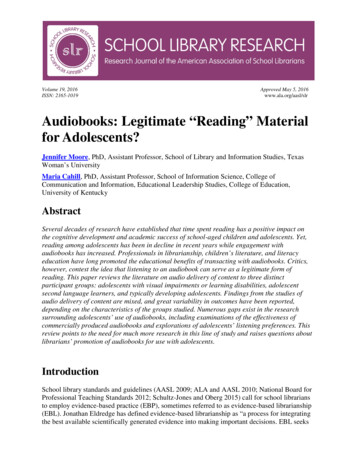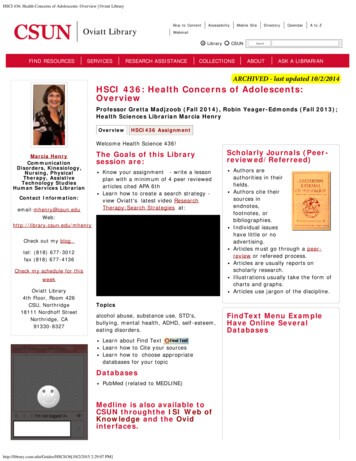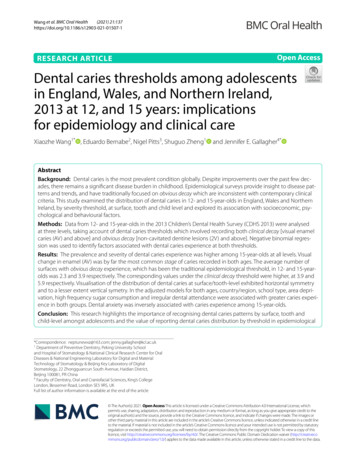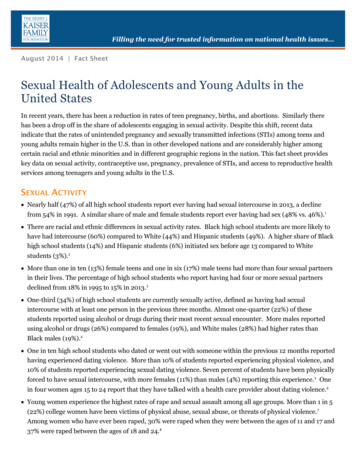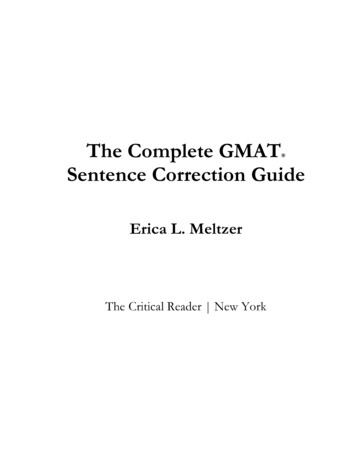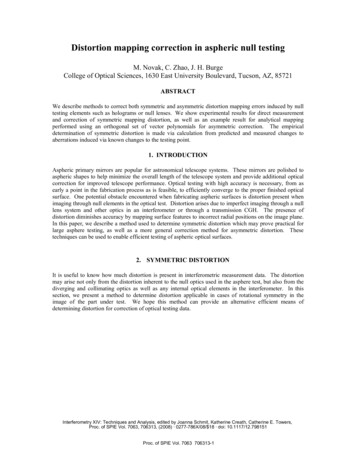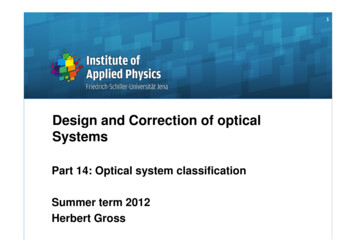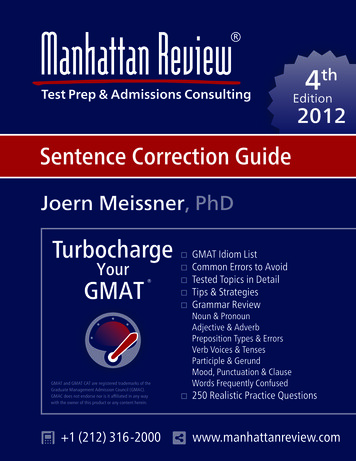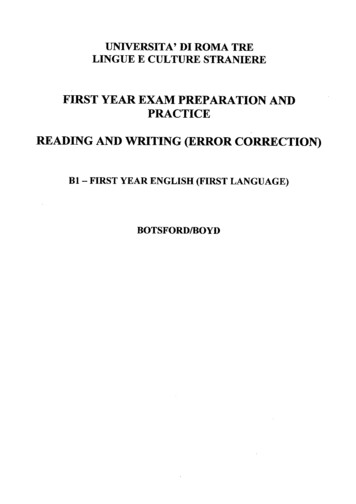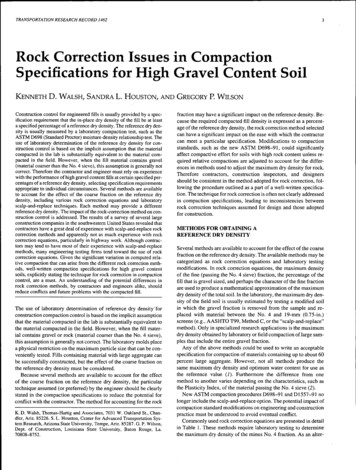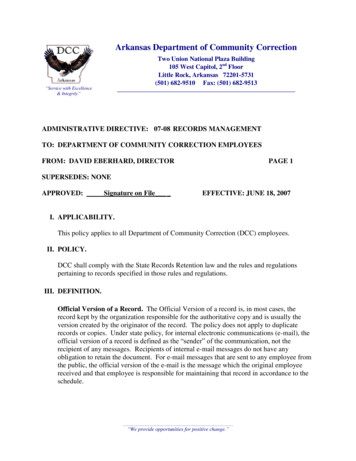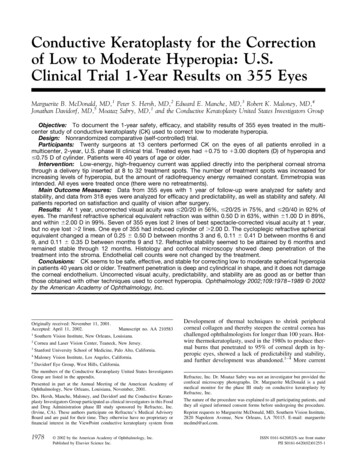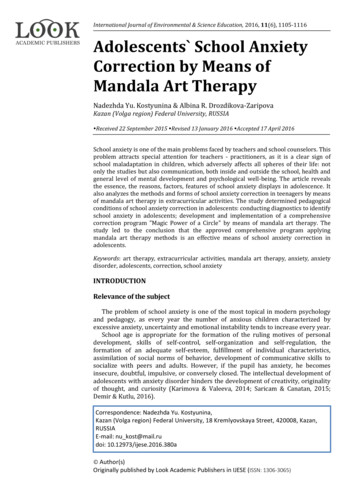
Transcription
International Journal of Environmental & Science Education, 2016, 11(6), 1105-1116Adolescents School AnxietyCorrection by Means ofMandala Art TherapyNadezhda Yu. Kostyunina & Albina R. Drozdikova-ZaripovaKazan (Volga region) Federal University, RUSSIA Received 22 September 2015 Revised 13 January 2016 Accepted 17 April 2016School anxiety is one of the main problems faced by teachers and school counselors. Thisproblem attracts special attention for teachers - practitioners, as it is a clear sign ofschool maladaptation in children, which adversely affects all spheres of their life: notonly the studies but also communication, both inside and outside the school, health andgeneral level of mental development and psychological well-being. The article revealsthe essence, the reasons, factors, features of school anxiety displays in adolescence. Italso analyzes the methods and forms of school anxiety correction in teenagers by meansof mandala art therapy in extracurricular activities. The study determined pedagogicalconditions of school anxiety correction in adolescents: conducting diagnostics to identifyschool anxiety in adolescents; development and implementation of a comprehensivecorrection program "Magic Power of a Circle" by means of mandala art therapy. Thestudy led to the conclusion that the approved comprehensive program applyingmandala art therapy methods is an effective means of school anxiety correction inadolescents.Keywords: art therapy, extracurricular activities, mandala art therapy, anxiety, anxietydisorder, adolescents, correction, school anxietyINTRODUCTIONRelevance of the subjectThe problem of school anxiety is one of the most topical in modern psychologyand pedagogy, as every year the number of anxious children characterized byexcessive anxiety, uncertainty and emotional instability tends to increase every year.School age is appropriate for the formation of the ruling motives of personaldevelopment, skills of self-control, self-organization and self-regulation, theformation of an adequate self-esteem, fulfillment of individual characteristics,assimilation of social norms of behavior, development of communicative skills tosocialize with peers and adults. However, if the pupil has anxiety, he becomesinsecure, doubtful, impulsive, or conversely closed. The intellectual development ofadolescents with anxiety disorder hinders the development of creativity, originalityof thought, and curiosity (Karimova & Valeeva, 2014; Saricam & Canatan, 2015;Demir & Kutlu, 2016).Correspondence: Nadezhda Yu. Kostyunina,Kazan (Volga region) Federal University, 18 Kremlyovskaya Street, 420008, Kazan,RUSSIAE-mail: nu kost@mail.rudoi: 10.12973/ijese.2016.380a Author(s)Originally published by Look Academic Publishers in IJESE (ISSN: 1306-3065)
N. Yu. Kostyunina & A. R. Drozdikova-ZaripovaMany researches are devoted to the study of school anxiety, both in Russian andforeign social pedagogy and psychology. However, having studied modernresearches of G. M. Breslav (1990), S. H. Blumberg (1985), C. E. Izard (1985), A. M.Prikhozhan (2000), Hosgorur & Apikoglu (2013), Ch. Spielberger (2002), one canstate that the number of experimental researches on the problem of adolescents’school anxiety correction is still meagre. Also, there is no comprehensive system ofmeasures aimed at preventing adolescents’ school anxiety by means of mandala arttherapy.Problem statementThe new educational standards requirements of the modern Russian school, thetransition from one level of education to another set for the fifth grade pupilschallenging tasks that are often beyond their abilities, breaking their emotional stateand causing critical adverse reactions. In this regard, the main feature of schoolmaladaptation in pupils to the educational environment is emotional trouble ofadolescents in secondary school (Kostyunina & Valeeva, 2015).Analysis of the problem in the psychological and pedagogical literature andpractice has revealed a number of contradictions:1) between the effects of various factors that put a teenager in trouble and hislack of knowledge of effective exit strategies from difficult situations.2) between the orientation of teachers, psychologists to address the problem ofschool anxiety and the insufficiency of the content, forms and methods ofdevelopment to ensure the effective correction of school anxiety of teenagers bymeans of mandala art therapy.Among the negative emotional experiences, anxiety occupies a special place.According to V. I. Dolgova & N. G. Kormushina (2009), it is due to the fact thatadolescents with high levels of anxiety have a high level of emotional disorder,uncertainty, timidity, minimal self-actualization. They have difficulties incommunication, rarely take the initiative, they have lowered learning motivation,and their behavior is close to neurotic, with obvious signs of maladaptation.Currently, the concepts of "anxiety" and "school anxiety" have come under thescrutiny of social psychology, psychopathology and social pedagogy.Psychological dictionary of A. V. Petrovsky and M. G. Yaroshevsky (1990) defineanxiety as individual psychological peculiarities, manifested in human tendency forfrequent and intense anxiety states, as well as the low threshold of its occurrence. Itis considered as personal foundation and /or as a property of temperamentassociated with the weakness of the nervous conditions.G. M. Breslav (1990) defines anxiety as a personality trait reflecting a decrease inthe sensitivity to different stress agents. Anxiety is expressed in constant sense ofthreat to one’s own self in any situations; anxiety is a tendency to experienceanxiety, characterized by a low threshold of occurrence of anxiety reactions which isone of the basic parameters of personality. A. M. Prikhozhan (2000) points out thatanxiety is the experience of emotional discomfort associated with the expectation oftroubles, a premonition of impending danger. There is a differentiation betweenanxiety as an emotional state and a common personality trait of temperament.Ch. D. Spielberger (2002) defines anxiety as a personality trait that predisposesthe individual to perceive a wide range of objectively safe circumstances ascontaining a threat, prompting to respond to them by T-states, the intensity of whichdoes not reflect the objective danger.Having studied the concepts of different authors such as: G. M. Breslav (1990) A.M. Prikhozhan (2000), Ch. D. Spielberger (2002) and others, in the current researchwe define anxiety as the generalized characteristic of mental activity associated withthe passivity, or block of nervous conditions, i.e. psychodynamic personality traits1106 Author(s), International J. Sci. Env. Ed., 11(6), 1105-1116
Adolescents school anxiety correction by means of mandala art therapymanifested in the adolescent’s interaction with the various components of theeducational environment and fixed in this interaction.As for school anxiety, according to A. V. Miklyaeva and P. V. Rumyantseva (2004),it is the specific type of anxiety characteristic of a certain type of situations situations of the child's interaction with the various components of schooleducational environment: the physical space of the school; human factors formingthe school subsystem "student - teacher - administration - parents"; trainingprogram.B. N. Phillip’s (1978) school anxiety diagnostic tests has eight factors, such asgeneral anxiety at school experience of social stress, frustration of the need tosucceed, the fear of self-expression, the fear of knowledge examination, fear offailing to meet the expectations of others, resistance to stress, fear in relationshipswith teachers. We studied manifestations of anxiety in adolescence. We clarify thatadolescence is the period from 11 to 16, which is characterized not only by highquality skills and beneficial changes in the body of a teenager and his inner circle,but also with the occurrence of specific states, which play an important role in theperiod of greatest development, being a dangerous link. It is during this period thatstable forms of behavior, character traits, methods of emotional response areformed; it is the time for achievements, for the rapid knowledge and skillsaccumulation; the formation of "self", the acquisition of new social position.However, this is the time when children's perception of the world disappears andfeelings of anxiety and psychological discomfort appear. At this age, attention tooneself and to one’s physical characteristics increases, reactions to the opinions ofother people and classmates, self-esteem and resentment aggravate. Adolescents’anxiety about developmental milestones tends to grow which is primarily due to theloss of developmental milestones, premature development and its delay. Anxiety isthe consequence of adolescent crisis, which flows differently and disorganizes theadolescents’ personality, affecting all aspects of their life.The purpose of the research is theoretical justification and experimentalverification of content, complex forms and methods ensuring the effective correctionof adolescents’ school anxiety by means of mandala art therapy (Asadullin et al,2016).Analysis of theoretical studies and practical activities in the context of theproblem developed showed that the issues related to the correction of adolescents’school anxiety are to date insufficiently studied sphere of scientific knowledge andpractice, which allowed the formulation of the hypothesis of the study of theproblem: the effectiveness of correction of adolescents’ school anxiety by means ofmandala art therapy can rise if the following is considered:- drawing on the essential characteristics of "anxiety", "anxiety state", "schoolanxiety";- taking into account the particular manifestations of school anxiety inadolescence;- considering the opportunities of mandala art therapy in adolescents’ schoolanxiety correction;- developing and implementing a comprehensive correctional therapy program"Magic Power of a Circle" to reduce the level of school anxiety in teenagers by meansof mandala art therapy (Sadovaya, Khakhlova & Reznikov, 2015).METHODSAccording to the hypothesis, on the basis of the understanding of the problem, itspurpose, the object and the subject of the research the following objectives weredefined: Author(s), International J. Sci. Env. Ed.,11(6), 1105-11161107
N. Yu. Kostyunina & A. R. Drozdikova-Zaripova1) to reveal the essence and content of the concepts of "anxiety", "anxiety state","school anxiety” on the basis of the analysis of psychological and pedagogicalliteratures;2) to determine the characteristics of school anxiety symptoms in adolescence.3) to develop the program content of correction of adolescents’ school anxiety bymeans of mandala art therapy;4) to test experimentally the effectiveness of the forms and methods of schoolanxiety correction by means of mandala art therapy.In accordance with the purpose and objectives of the study, the followingmethods were used:1) theoretical: study and analysis of psycho-pedagogical, methodological andlegislative literature, guidelines and procedures, documents and materials on thetopic of the present research, study and generalization of innovative social andpedagogical experience, analysis, synthesis;2) empirical - observations, surveys, tests, experiments;3) methods of qualitative interpretation and processing of the data (parametricStudent's t-test for dependent samples).Detecting school anxiety in adolescents was carried out by means of the followingmethods:1) testing and questioning the parents in order to get information about theproblems of the child in school at the stage of social adaptation to the newconditions of learning, namely: a) the test "Is everything going well in your child'sschool?", b) the questionnaire on detecting anxiety states in children developed byG. P. Lavrentieva & T. M. Titarenko (2000).2) survey of students using questionnaires developed by N. G. Luskanova(1993) to assess the school motivation level;3) «Color Test of Relations» (CTR) developed by A. M. Etkind (2001) to revealthe emotional attitude of students to the school and school life, and the attitudes tothemselves and others;4) school anxiety questionnaire developed by B. N. Phillips. This standardizedpsycho-diagnostic method helps to evaluate not only the overall level of schoolanxiety, but the unique nature and quality of anxiety states related to different areasof school life. The following eight factors serve as the subject of the analysis in thegiven method:1) "general anxiety in school" - the child's general emotional state connected withdifferent forms of his inclusion in the life of the school;2) "the experience of social stress" - the emotional state of the child, associatedwith his social contacts (mainly - with peers) development;3) "frustration of needs to succeed" - an adverse psychological background, notallowing the child to develop his needs for success, to achieve a good result;4) "the fear of self-expression" - negative emotional experiences of situationsassociated with the necessity to show oneself in front of others, and demonstrateone’s abilities;5) "the fear of knowledge examination" - negative attitudes and experience ofanxiety in situations of testing (especially - public) knowledge, achievements,opportunities;6) "the fear of not meeting the expectations of others" - focus on the importanceof others in the evaluation of their results, actions, and thoughts, anxiety about theassessment given by others, the expectation of negative assessment;7) "low physiological resistance to stress" – peculiarities of psycho-physiologicalnature of the child reducing the child's adaptability to stressful situations thatincrease the likelihood of inadequate, destructive response to the disturbingenvironmental factor;1108 Author(s), International J. Sci. Env. Ed., 11(6), 1105-1116
Adolescents school anxiety correction by means of mandala art
Psychological dictionary of A. V. Petrovsky and M. G. Yaroshevsky (1990) define anxiety as individual psychological peculiarities, manifested in human tendency for frequent and intense anxiety states, as well as the low threshold of its occurrence. It is considered as personal foundation and /or as a property of temperament associated with the weakness of the nervous conditions. G. M. Breslav .
